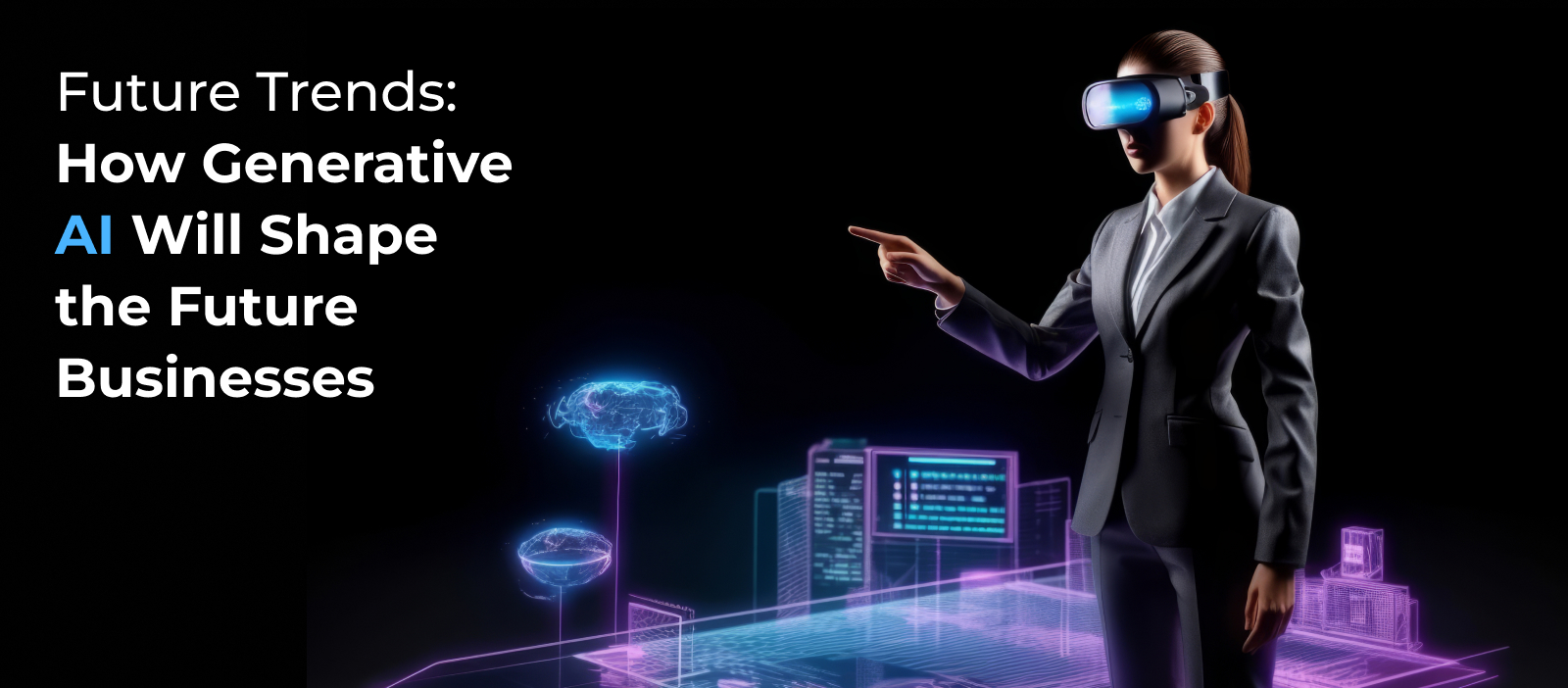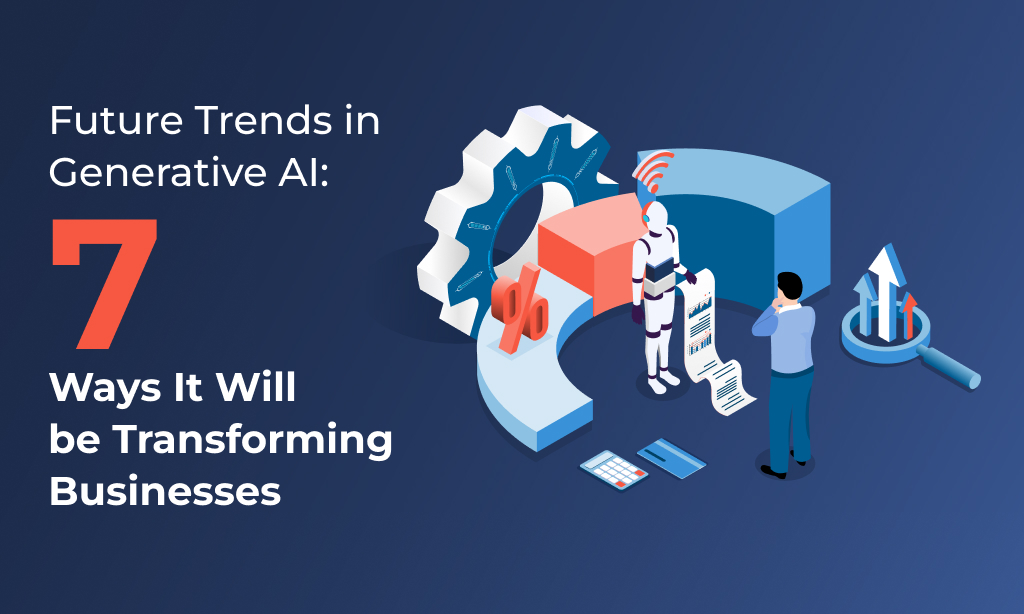Future Trends: How Generative AI Will Shape the Future Businesses
October 17, 2024

In current times, artificial intelligence is no longer a futuristic concept. AI is making an entry into the daily life of business. Among the many branches of AI, generative AI is highlighted as one of the most transforming technologies. Compared to the traditional AI that extracts and analyzes existing data, generative AI helps in content creation, idea generation, design creation, and decision-making, and helps in creating business strategies. These changes can impact the overall efficiency and productivity of any business, leading to exponential growth.
Generative AI empowers businesses to create diverse and engaging content. By automating repetitive tasks businesses are getting more resources to focus on their main agenda. Gen AI is transforming organizations in terms of personalization, increased efficiency, and enhanced decision-making ability. By leveraging generative AI, businesses can stay ahead of the competition. It is reshaping operations by driving efficiency, enhancing creativity, and enabling personalization. In this topic, we are going to learn how Gen-AI will shape the future of businesses.
7 Ways Generative AI Will be Transforming Businesses

1. Enhanced creativity and content generation
One of the most significant impacts of Gen-AI is in content generation. Generative AI can create content infinitely in the form of text, images, and videos. It has led to an increase in creative content across the globe. Businesses can benefit from this by implementing it in their marketing tactics. Gen AI allows not just businesses but every individual who can give creative input to generate out-of-the-box ideas and content. Not only that, generative AI can help you create a marketing strategy based on user data. It can give personalized content to increase customer engagement. For businesses, this means faster content production, personalization at scale, and more targeted campaigns.
Generative AI has the ability to create stunning visuals, whether it’s designing graphics, generating realistic images, or creating art from text input. With tools like DALL-E and MidJourney, anyone can create incredible imagery. For authors, it can play a significant role in creating book covers that fit perfectly with their ideas. Educational institutes can use gen AI to create visual aids to enhance the learning material and improve the learning curve of students. This way generative AI can help create creative and personalized content organizations.
2. Enhancing Product Development and Design
AI is revolutionizing product development and design by streamlining processes, enhancing creativity, and improving productivity. It accelerates the product design process by automating repetitive tasks and acts as a design assistant for designers. This reduces time spent on manual tasks like drawings, blueprints, 3D models, etc. AI-powered tools allow designers to input design requirements and generate related design concepts based on input. Then these concepts can be tested and redesigned to select the best design faster than before. After selecting, we can test the design on AI-powered software for various parameters and conditions. Based on the result, the design can be finalized. This allows business for rapid prototyping.
By analyzing large datasets, AI can create a user-centered design for better interaction and engagement. With this data, companies can make more personalized, user-friendly products and designs that resonate with their target audience. Gen-AI can analyze data and predict upcoming trends based on consumer behavior data. This helps the product development team to understand the customer requirements and design the product that resonates with them. AI tools can study user interactions, and based on that data, they can give feedback to improve the product and its design. Plus, it can predict the data points for potential failures and recommendations for improvement. It allows manufacturers to improve product reliability and reduce downtime.
Thanks to AI, promoting sustainability by optimizing material usage, energy consumption, and waste management during the design process. AI-driven tools help designers explore alternative materials and eco-friendly materials for better sustainability. By analyzing design, AI can lower the material waste in manufacturing, allowing materials to be used more efficiently. When it comes to materials, AI can optimize supply chain management by analyzing material requirements, transportation costs, and the environmental impact it has, resulting in a reduced carbon footprint. In other words, it is fair to say that AI plays a major role in environmental sustainability, as many countries across the globe decided to reduce their carbon footprint. The best place to start is the industrial area, as they contribute one-fifth of the world’s carbon footprint.
3. Automating Customer Service with AI Chatbots
Generative AI chatbots can provide highly personalized responses to customers based on their context, previous chats, interactions, and preferences. The current chatbots that work on rule-based responses are less likely to be used by businesses after integrating AI into them. These AI chatbots can craft unique responses based on the customer’s questions and needs. They are available 24/7 and can handle multiple conversations simultaneously. These chatbots can operate around the clock and ensure customers are getting answered whenever they want to. Unlike traditional, where the customer has to wait to get the answer from the other end, now with the help of AI they will be able to solve their problems within a few minutes. They are revolutionizing E-commerce sites that handle many customer inquiries about their products, shipping status, returns, and product details anytime. Additionally, the response time has significantly decreased.
4. Driving Innovation with AI-Powered Research and Development
AI is rapidly reshaping traditional R&D processes, allowing companies to accelerate discoveries, enhance creativity, and solve complex problems more efficiently. AI’s ability to analyze vast datasets and identify patterns helps companies make discoveries quicker and better. Predictive analytics help organizations forecast future trends, predict outcomes, innovative solutions, and other possible outcomes based on historical data. For example, in the pharmaceutical industry, based on old data, AI can tell which chemical compound will help cure a particular disease effectively. This decreases the time required for testing and figuring out the medicine for any disease. Along with that, it reduces the cost of drug development.
AI can automate repetitive and time-consuming tasks, freeing researchers time to focus on higher-priority tasks. Through ML, AI can enhance the product design and development process and help the R&D team come up with new products by collecting and analyzing data. It reduces the time required for market research and can come up with more personalized, accurate product ideas and designs. By integrating AI into their R&D processes, companies can not only shorten the time to market for innovations but also ensure their products meet the ever-changing demands of today’s consumers.
5. Boosting Employee Productivity with AI Assistants
AI-powered assistants are becoming invaluable tools for boosting employee productivity. These tools are transforming how we work by automating routine tasks, improving decision-making, and streamlining communication. AI assistants are perfectly capable of automating repetitive tasks, allowing employees to focus on the main part. From scheduling meetings to managing emails AI can handle these tasks with minimal human intervention. For example, Google Assistant can automatically organize meetings by checking the calendar.
AI assistants can analyze large amounts of data sets and provide actionable insights. This helps employees to make better decisions based on data. It allows employees to access real-time data and predictive analytics for making decisions. They can even automate workflows and streamline communication with the team. This increases employee productivity and overall efficiency.
6. Facilitating Hyper-Personalized Marketing
By analyzing the old data and customer interaction history, generative AI can help come up with hyper-personalized marketing strategies. For example, in email campaigns, based on user interaction with past emails, generative AI can personalize the email copy to improve the customer experience and engagement. This capability allows the business to personalize their outreach messages to customers and improve customer interaction with their products and services. When it comes to online marketing, based on real-time feedback, businesses can target marketing campaigns based on audience behavior, preferences, and interactions. AI can personalize the customer journey when it comes to marketing. A personalized landing page, follow-up emails, and marketing copy that feels uniquely tailored to the audience’s needs. Also, AI can help in automating A/B testing and optimizing marketing campaigns in real-time to determine which versions of content are most effective for different segments.
By automating content creation, optimizing campaigns in real-time, and delivering predictive insights, AI allows marketers to build stronger, more personalized connections with their audience.
7. AI-as-a-Service Models (AIass)
AI as a service is a cloud-based platform that provides access to artificial intelligence tools and capabilities. It is a cost-effective service and a low-risk way for businesses to use AI without having to develop their AI from scratch. Businesses of all sizes can access and integrate AI functionality in their system on a subscription basis, or a pay-per-use model. There are types of AIass, depending on operational needs. Bots and virtual assistants, machine learning frameworks, application programming interfaces, and AI of things.
Bot and virtual assistants use machine learning and natural language processing to learn from human interactions and give personalized responses. By using machine learning frameworks, businesses can create custom-made AI models. Application programming interfaces (APIs) enable different software applications and systems to communicate, interact, and exchange information. AI-as-a-Service (AIaaS) providers offer APIs that allow businesses to integrate their existing systems with AI-powered tools effortlessly, without the need to develop AI models on their own. Artificial Intelligence of Things (AIoT) embeds AI technology and machine learning capabilities into IoT, analyzing data to identify patterns, gather operational insights, and detect and fix problems. AIaas can help businesses of all sizes implement AI-driven technologies to scale their business, serve customers, and cost-effectively adopt new technologies.
Businesses are using AI technology to grow their businesses and solve the challenges they are facing daily.
Conclusion
Generative AI represents a disruptive technology that has the potential to transform businesses. Not only does it increase operational efficiency but also helps employees streamline their workflow. Generative AI is helping businesses in creative fields, marketing, and research and development. It enables hyper-personalization, automates repetitive tasks, boosts productivity, and acts as a copilot for employees to improve their productivity and efficiency. As businesses look to the future, embracing these trends and leveraging generative AI’s capabilities will be key to staying competitive, driving growth, and delivering exceptional value to customers.
Keep reading about
LEAVE A COMMENT
We really appreciate your interest in our ideas. Feel free to share anything that comes to your mind.
Our 16 years of achievements includes:
-
10M+
lines of codes
-
2400+
projects completed
-
900+
satisfied clients
-
16+
countries served




